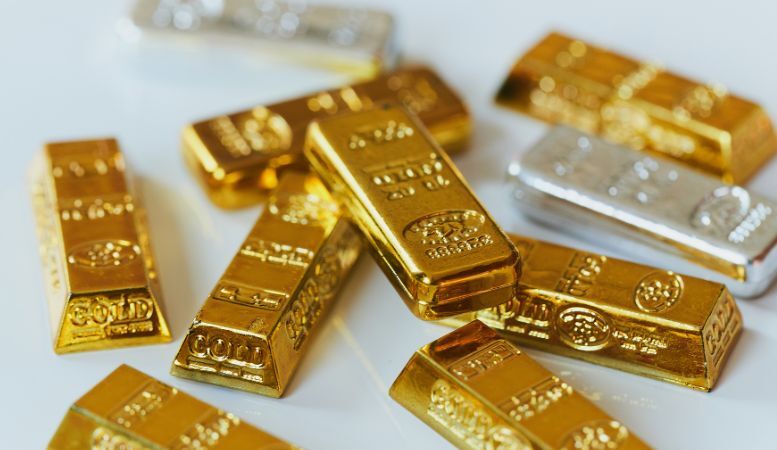Table of Contents
Conversions to Grams
If you’ve just started your precious metals investing journey, you may have encountered products sold by troy ounces. Unless you’re a history buff, such a term is probably unfamiliar to you. That’s because we don’t use troy ounces to measure the weight of very many things anymore, except for metals such as silver and gold.
Exactly how many grams are in a troy ounce, and how does this measurement affect the price of precious metals? Below, you’ll learn how many grams are in a troy ounce of gold and silver, along with the fascinating history of the troy measurement system. Having this knowledge under your belt will ensure you make more informed decisions regarding personal wealth management.
What Is a Troy Ounce?
The troy ounce is a unit of measure for weighing precious metals, such as gold, silver, platinum, and palladium. You may also see gemstones for sale by the troy ounce, but sellers more often price gemstones by the carat.
The troy ounce is the only measure of the troy weighting system that’s still widely used in the modern era. Other troy weight units include the grain, the pennyweight, and the troy pound (equal to 12 troy ounces).
How many grams are in a troy ounce? One troy ounce equals 31.1 grams.
Troy Ounce vs. Ounce

If you like to bake, you may be familiar with liquid ounces, which measure things such as milk and water, and dry ounces, which measure ingredients like flour and sugar. The troy ounce differs from the liquid or dry ounce, so be sure not to confuse it with these measurements when buying silver or gold.
Dry ounces measure weight, whereas liquid ounces measure volume. One pound contains 16 dry ounces, and one dry ounce contains 28.35 grams. One cup holds eight liquid (or fluid) ounces, and there are 16 fluid ounces in a pint.
Additionally, the symbol for a troy oz is “t oz”, whereas an ounce is simply “oz”. Be sure not to get these mixed up.
If you’re wondering how many grams are in a troy ounce of silver, the answer, as noted above, is just over 31 grams.
Other Troy Ounce Conversions
We can also convert troy ounces into other units of measurement, such as pounds, kilograms, and troy pounds. One troy ounce is equal to:
- 0.0685714 pounds
- 0.0311035 kilograms
- 155.5 carats
- 480 grains
- 20 pennyweight
- 0.08333333333 troy pounds (equal to about 12 troy ounces)
That last conversion is particularly important to pay attention to. One troy pound weighs 12 troy ounces, compared to a standard pound that weighs 16 ounces. If you see gold or silver for sale by the troy pound, you may think you’re getting 16 ounces of gold. Not so, because 12 troy ounces is only equal to about 13 regular ounces (or 369 grams).
This matters because some unscrupulous sellers will list gold and silver by the troy pound in an attempt to confuse you. But you won’t be fooled now that you know how many grams are in a troy ounce of gold.
To minimize confusion, most legitimate precious metals sellers will list gold and silver by the troy ounce or kilo. If a seller lists precious metals by the troy pound, ask how many ounces you’ll get for your money.
What Is the Avoirdupois Ounce?
Avoirdupois is a system of measurement that uses ounces and pounds as units. Translated from French, it means “goods of weight.”
The avoirdupois measurement system came into use in the 13th century. In 1959, countries around the world agreed to standardize the definitions of ounce and pound. It was from this standardization that the International Avoirdupois Pound came to be.
Although you may not be familiar with the term, avoirdupois is the standard system of weights used in the United States. Other countries that use the avoirdupois measurement system include Canada, the United Kingdom, Australia, and New Zealand. Some former British colonies use this system as well.
One avoirdupois pound weighs exactly 0.45359237 kilograms or 453.6 grams. Comparatively, one troy pound weighs about 373 grams.
If you see gold for sale by the troy pound, remember you’re not buying as many ounces as you’d get when purchasing by the avoirdupois pound.
Converting the Price of Silver and Gold

To convert the price of silver or gold, you must multiply the mass value by the equivalent of one troy ounce. A few common conversions include:
- Grams = Mass value x 31.1035
- Avoirdupois ounces = Mass value x 1.097
- Pounds = (Mass value x 1.097) / 16
- Troy pounds = Troy ounces / 12
To convert the quoted price per kilogram of gold and silver, you have two options:
- Grams conversion = (Mass value x 31.1035) / 1,000
- Pounds conversion = (Mass value x 1.097 / 16) x 2.205
History of the Troy Ounce
The history of the troy measurement system is a very long and interesting one dating back thousands of years. Historians know the troy system originated in 15th-century England, but the source of the troy name is somewhat debatable.
Charles Moore Watson, who lived from 1844 to 1916, thought the name came from the term troni ponderacionem. Watson believed the word troni referred to the dialectal troi, meaning balance.
Other historians think the name came from the French town of Troyes. Here, English merchants traded as far back as the ninth century. The word “troy” first appeared in 1390 and was used by the Earl of Derby to describe the weight of a platter.
Still others believe the troy weight system came from Muslim domains and the gold dirhem (which was worth about 48 British Imperial grains).
The troy system contains many aspects of the Roman currency system. Ancient Romans used bronze bars as currency before switching to coins. An aes grave, or heavy bronze bar, weighed one pound.
The troy ounce was also once widely used as part of the apothecaries’ system, a historical system of weights and measurements used by doctors and scientists. The troy system has mostly been replaced by the metric system (milligrams) in medicine.
Troy weights were officially approved for silver and gold in 1527. The modern troy ounce is the same as the British Imperial troy ounce used from 1824 to 1971. The United States adopted the troy measurement system for silver and gold via an Act of Congress on May 19, 1828.
Troy ounces are used to measure gold and silver in many countries that otherwise use the International System of Units (SI), with the exception of some East Asian countries. China used troy units for its Gold Panda coins from 1982 to 2016. In 2016, China replaced troy ounces with integer numbers of grams.
How To Buy Gold and Silver Without Getting Ripped Off

Understanding how many grams are in a troy ounce can seem a little overwhelming, but it’s important to know if you plan to invest in precious metals. Otherwise, you could end up with far less gold than you expected for your money.
Pawn shops are particularly notorious for gold and silver scams. Some sellers deliberately misrepresent the weight of gold to earn more per sale while giving you less. If a pawn shop owner sells gold by the ounce, ask whether they mean troy ounces or avoirdupois ounces. If the owner doesn’t know or won’t tell you, it’s best to take your business elsewhere.
The following are a few more tips to help you buy gold without falling victim to a scam:
- Know the spot price of gold and silver before you buy. The spot price is the current price of one troy ounce of gold or silver. The higher the spot price, the higher the demand. If a seller offers gold at a rate that’s far higher than the spot price, they might be trying to rip you off. By the same token, if the going rate is far lower than the spot price, the seller could be trying to offload counterfeit coins or bars.
- Look for gold and silver with weights and purities engraved on each piece. This will eliminate any doubt as to how much a coin or bar is worth. You’ll also have an easier time selling engraved precious metals later on.
- Bring a pocket scale that measures in troy ounces with you when buying gold or silver. This won’t help if you buy online, but if you’re open to purchasing precious metals in person, using a scale to weigh gold and silver prevents you from getting ripped off. If the weight is below what you expected for the size, the item could be counterfeit.
- Know the dimensions of the coins or bars you want to buy. Counterfeit gold and silver will usually be a little thicker or have a bigger diameter than the real thing.
- Use a magnet to see whether the metal sticks to it. Precious metals won’t stick to magnets, but counterfeit coins and bars do.
- Only buy gold and silver bullion from a reputable precious metals dealer. To find a legit dealer, ask how long they’ve been in business, and be sure to check out reviews from other buyers. If reviewers mention unfair prices or shipment delays, it may be wise to choose another dealer.
- Avoid private transactions unless you’re experienced with precious metals investing and have a good idea of what you’re looking for.
Other Ways To Invest in Precious Metals

Buying physical gold and silver bullion isn’t the only way to invest in precious metals. If you’d rather not worry about troy ounces and don’t want to fuss with weight conversions, you have a few other options:
- Some investment companies and banks allow you to buy gold certificates. These certificates were once a usable form of government-issued currency, but no longer. Nowadays, gold certificates are backed by the entity from which you purchase them.
- You can buy futures and options for gold, silver, and other precious metals.
- Commodity exchange-traded funds (ETFs) and mutual funds allow you to buy and sell shares of precious metals. You don’t take physical delivery of any gold or silver when going this route.
- You can purchase stock shares of companies in the mining and precious metals sectors. With this option, you’re essentially betting on whether a company will be able to find and extract gold, silver, or other precious metals.
Contact Oxford Gold Group To Learn More About Investing in Gold and Silver
Now that you’ve learned how many grams are in a troy ounce of gold and silver, we invite you to reach out to Oxford Gold Group to find out more about adding precious metals to your portfolio. We can help you decide whether investing in gold, silver, or other precious metals is right for you.
Reach out to us for your free precious metals investment guide, or call (833) 600-GOLD to learn about our physical products and IRAs today.








